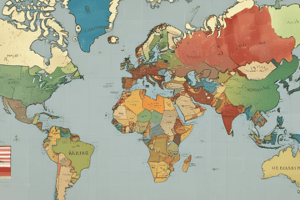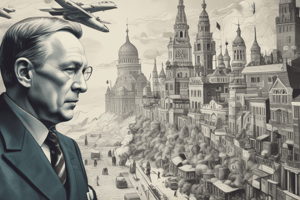Podcast
Questions and Answers
What is the primary objective of the Non-Alignment Movement (NAM)?
What is the primary objective of the Non-Alignment Movement (NAM)?
- To join military alliances with superpowers
- To pursue colonial policies in newly decolonized countries
- To eliminate global economic inequalities (correct)
- To promote a policy of neutrality on global issues
What is a characteristic of military alliances formed by superpowers during the Cold War?
What is a characteristic of military alliances formed by superpowers during the Cold War?
- Superpowers do not provide military assistance to member countries
- An attack on one member country is considered an attack on all member countries (correct)
- Member countries are not required to provide military support to the superpower
- Member countries are free to pursue their own ideology
Why did the superpowers engage in an arms race during the Cold War?
Why did the superpowers engage in an arms race during the Cold War?
- To support the Non-Alignment Movement
- To demonstrate their military power and deter their opponents (correct)
- To promote arms control agreements
- To reduce their military capabilities
What was the primary reason for the superpowers to form military alliances with smaller countries?
What was the primary reason for the superpowers to form military alliances with smaller countries?
What is NOT a feature of military alliances formed by superpowers during the Cold War?
What is NOT a feature of military alliances formed by superpowers during the Cold War?
Which of the following countries was a member of the Non-Alignment Movement?
Which of the following countries was a member of the Non-Alignment Movement?
What was the primary reason for the development of arms control agreements during the Cold War?
What was the primary reason for the development of arms control agreements during the Cold War?
What is the term for the policy of not joining any military alliances?
What is the term for the policy of not joining any military alliances?
What is the primary objective of the Non-Alignment Movement in terms of global issues?
What is the primary objective of the Non-Alignment Movement in terms of global issues?
Why did the superpowers engage in military alliances with smaller countries?
Why did the superpowers engage in military alliances with smaller countries?
Flashcards are hidden until you start studying
Study Notes
The Cold War Era
- The Cold War led to the division of Europe into rival alliances, with the Western bloc led by the United States and the Eastern bloc led by the Soviet Union.
- The Western alliance, known as the North Atlantic Treaty Organisation (NATO), was formalized in 1949 and consisted of 12 states that declared mutual defense in case of an attack.
- The Eastern alliance, known as the Warsaw Pact, was created in 1955 and led by the Soviet Union, with the primary function of countering NATO's forces in Europe.
Capitalist Bloc
- Countries that belonged to the Capitalist Bloc during the Cold War include:
- Italy (capital: Rome)
- Turkey (capital: Ankara)
- Greece (capital: Athens)
Communist Bloc
- Countries that belonged to the Communist Bloc during the Cold War include:
- Yugoslavia (capital: Belgrade)
- Bulgaria (capital: Sofia)
- Albania (capital: Tirana)
Non-Aligned Movement
- The Non-Aligned Movement (NAM) was formed by newly independent countries to stay out of the rival alliances and pursue independent policies.
- The movement enabled countries to follow a policy of neutrality on global issues and focus on eliminating global economic inequalities.
Features of Military Alliances
- Key features of military alliances formed by the superpowers include:
- Mutual defense in case of an attack on any member country
- Member countries providing bases for the superpowers in their respective lands
- Member countries supporting the superpower in terms of ideology and military strategy
- However, superpowers did not assist all member countries in developing their own nuclear weapons.
Countries and Their Blocs
- Countries and their respective blocs during the Cold War include:
- Poland: Communist Bloc
- France: Capitalist Bloc
- Japan: Capitalist Bloc
- Nigeria: Non-Aligned Movement
- North Korea: Communist Bloc
- Sri Lanka: Non-Aligned Movement
Arms Race and Arms Control
- The Cold War produced an arms race as well as arms control, primarily due to the rivalry and competition between the superpowers.
- The arms race led to a buildup of military capabilities, while arms control efforts sought to reduce the threat of nuclear war and promote disarmament.
Reasons for Superpower Military Alliances
- The superpowers formed military alliances with smaller countries for three main reasons:
- To counter the influence of the rival superpower
- To secure strategic locations and resources
- To promote their respective ideologies and interests
Studying That Suits You
Use AI to generate personalized quizzes and flashcards to suit your learning preferences.




